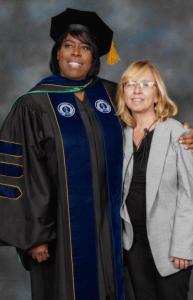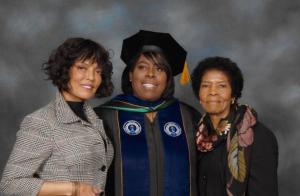Dr. Glenda R. Taylor's Amazing Journey
Dr. Glenda R. Taylor's intellectual vision unaffected by loss of sight.
Because Mary J. Taylor told her daughters nothing was beyond their achievement, her sister Shay, became a successful fitness model and Glenda is now Dr. Glenda R. Taylor, earned in 2017 for her doctoral thesis, Tradition, Consciousness, Social Justice, and the Creative Process: An Interdisciplinary Approach to the Study of the Artistry of Michael Jackson.
Taylor’s thesis, according to one reviewer, “deconstructs his (Jackson’s) evolving consciousness, unveils his creative process, and decodes his songs and short films based upon his unique perspective.” Taylor’s dissertation was nominated for the 2017 Marvin B. Sussman Award, awarded nationally to the most outstanding dissertations of that year’s graduating class.
Mary J. Taylor’s admonition, and her daughter’s writing, gave the world the books: Crossing Boundaries: The Joseph Jackson Story (2019), Corridors of Genius: Excavating the Consciousness, Creative Process, & Artistry of Michael Jackson (2018), Wanna Be Startin’ Somethin’: Michael Jackson - A Social Activist? (2017), Waves of Consciousness (2014), The Jalimuso’s Drum: African American Female Entertainers as Cultural Historians (2011), Truth Beyond Illusion: African American Women 1860s – 1950s (with Mary J. Taylor) (2009), The Secrets of Success: The Black Man’s Perspective (with Mary J. Taylor) (1999), The Secrets of Success: Quotations by African-American Achievers (1998), plus another four volumes of poetry.
Taylor also created the virtual Glenda R. Taylor Museum, a repository of rare African and African American art; the Dr. Glenda R. Taylor Gallery YouTube video, and interviews with artists including Cissy Houston, Dionne Warwick, Nettie P. Jones, Louise Meriwether and Joe Jackson, Michael’s father.
What makes Taylor’s accomplishments even more impressive is that many of them came after 2001, the year she was diagnosed with Papilledema Pseudotumor Cerebri, a condition in which the body over-produces spinal fluid. The excess fluid puts pressure on the optic nerves.
On May 21, 2001, Taylor lost 95-percent of her vision. She was 45 years old.
Before that date Taylor earned an English degree from Medgar Evers College; helped build the Brooklyn based nonprofit Urban Strategies into a large multi-service agency; founded Olympic Vision (1992), which helps New York City residents, community based organizations, and small businesses access supportive services; traveled to Ghana, Togo, Benin and Nigeria in West Africa; started a 30 year study of yoga, Eastern philosophy, and Ayurvedic medicine and had mounted over one hundred art exhibits in Harlem and Brooklyn.
Letting her vision loss limit her life would have been easy. But Taylor did not narrow her intellect or goals. Instead, inspired by the African American entertainers, writers, and cultural historians she had studied, she used their strength to buttress her own.
“I turned to these artists because I wanted to know how to retain my creative spirit,” Taylor said. “I never had blind consciousness, accepting the limitations blindness can put on you, like they did not accept the bondage racism imposed on them.
“A white man saw Etta James use a whites-only bathroom while traveling through the South. He put a gun her black driver’s head and said he would kill him if she did not apologize.
“Betty Shabazz had four kids and was pregnant with twins when she saw Malcolm X, her husband killed. Medgar Evers died in (wife) Myrlie Evers’ arms after he was shot in his driveway.
“Blindness is nothing compared to what these people experienced,” she said. “You keep going. Just like if your car breaks down, you have to find another method to get to your destination.”
Taylor’s intellectual voraciousness was matched by her mother’s dedication.
Mary J. Taylor’s help was instrumental in getting Taylor through Union Institute and University’s doctoral program. They visited multiple states doing research and took classes on the Cincinnati campus. University President Dr. Roger Sublet gave Mary Taylor the school’s first “Tender Loving Care” award at Glenda’s graduation, for her dedication.
Taylor continues feed her intellect. Her virtual museum draws on an interest in all things African and African American, one she has fed since she was nine years old – her personal collection includes thousands of Ebony, Jet and Black Enterprise magazines.
“(Activist and comedian) Dick Gregory said that the Negro must take charge of his image, of how he is perceived,” Taylor said. “Understanding history is a part of that process.” That is one reason Taylor chose Michael Jackson as her dissertation topic, focusing on his upbringing, influences, and creative process rather than the pedophilia accusations that damaged his career and public image.
“I was researching creativity and African American female artists when Michael, then Whitney Houston, died. I decided to explore Michael’s creativity by analyzing the roots of artistic genius in his work, not gossip and allegations,” Taylor said. “Most of the people conducting academic research on Jackson are not looking through the lens of his African American roots or his religious foundation.”
Too much about Jackson has been obscured by his fate, Taylor said. “You would never know he was addicted to reading books, that he studied Eastern philosophy, that he may have had a photographic memory because he could watch people doing a move once and copy it exactly.
“Jackson’s ‘Black or White’ video shows he knew the world began in Africa, that we are one human species with different cultures,” Taylor said. “He proved he knew his heritage when he sang ‘I am Here Because You Were There’ to Sammy Davis Jr.
“So much about his life and career shows Jackson’s art was rooted in African American history and culture.”
Taylor believes preserving African American history is one of her raisons d’etre.
“The Bible says nothing is impossible unto you, so how can you not try things others believe to be impossible?” Taylor said. “It may not happen how and when I envision it, but that won’t stop me from trying.”
Dr. Glenda R. Taylor
Dr. Glenda R. Taylor
+1 212-531-0322
Glenda@GlendaRTaylor.com
Visit us on social media:
LinkedIn
The Glenda R. Taylor gallery
Legal Disclaimer:
EIN Presswire provides this news content "as is" without warranty of any kind. We do not accept any responsibility or liability for the accuracy, content, images, videos, licenses, completeness, legality, or reliability of the information contained in this article. If you have any complaints or copyright issues related to this article, kindly contact the author above.



